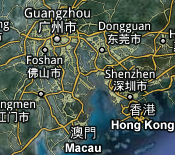 The Guangdong province of China (and specifically the Pearl River delta) was THE country’s hub for export manufacturing in the 1980s. But the situation has changed a lot:
The Guangdong province of China (and specifically the Pearl River delta) was THE country’s hub for export manufacturing in the 1980s. But the situation has changed a lot:
- Local governments are pushing many industries out, to make room for residential buildings or simply to focus on the highest-value-added sectors.
- More and more factories are set up in other coastal regions and in inner provinces.
- The migrant workforce is increasingly reluctant to work away from their home towns.
So, is manufacturing going to leave Guangdong? I don’t think so.
First, a bit of historical perspective
From 1949 to 1978, China was totally closed. There was virtually no export industry.
In 1978, China starting opening up. The leaders of the day wanted to run an experiment as far from Beijing as possible, so the first “Special Economic Zone” was right across the border from Hong Kong.
Something absolutely unique happened at this time in History, as the CEO of Li & Fung explains in this video: foreign specialists came to set up production facilities, cheap migrant workers came by the millions, and this system has exerted a strong deflationary pressure on the World’s economy for several decades.
Right now might be the opening of a third 30-year period. China will still be a producer, but the factories tend to relocate to inland provinces.
What will coastal provinces like Guangdong specialize in?
The Pearl River delta’s industry is clearly moving up the value chain. Production of electronics, industrial goods, pharmaceuticals, and cars is slowly replacing textile, shoes, and cheap home appliances.
There will be two key advantages to manufacturing in Guangdong:
1. Higher quality and better understanding of foreign markets
The manufacturing sector is much more experienced, which translates into better average quality. These new factories in Anhui or in Hunan look nice, they are cheap, but they are probably not very reliable.
Hundreds of thousands of foreigners, including many Chinese from Hong Kong or Taiwan, live in (or commute weekly to) cities like Shenzhen, Dongguan, or Zhongshan. They have trained managers and technicians. They have experienced all sorts of production issues, and they have set up rules to minimize their occurrence.
They have also been in extensive contact with their customers. They have a better idea of what is acceptable and what is not.
What does it mean for foreign buyers? Higher prices but fewer headaches. For certain importers, this choice makes a lot of sense.
2. Higher flexibility
What happens when you have a massive production base in one place? There has got to be some interesting dynamics, right?
What is unique in Guangdong is that one can find virtually any manufactured product in a radius of 100 miles around Dongguan/Guangzhou. Local manufacturers represent hundreds of product lines, and their sub-suppliers (many of which are foreign-owned and have brought new technologies) are located next to them.
And let’s not forget about the Hong Kong and the Shenzhen ports, which are among the busiest in the world, and which are located right in the middle of the delta.
As David Levy wrote recently on this topic:
Producing in Guangdong, we can optimize the mature supply chain and logistical environment to add value by drastically lowering minimum order sizes and delivery times. That strategy may be more challenging in areas (or countries) where raw materials and components need to be imported in bulk, and where production management skills are suitable for large production runs.
I couldn’t write is better… Lower minimum order quantities, faster production, excellent logistics, and proximity of World-class ports.
Do you agree?

John, I understand the pollution, both electronic waste based, as well as that generated by mining, etc. is/has turned this broader region of China into an industrial environmental wasteland. Have any improvements been made with respect to the heavy metals in both the water and food supply? Also of concern is the very high rate of cancer amongst villagers in the area. I believe many from the west are utterly stunned when they see film from this broad region.
Glenn,
Guangdong air is less polluted than in Beijing, Qingdao, or Shanghai.
The e-waste graveyards are only in a small fraction of the province.
The provincial government is aware of it and has been making real efforts for at least 5-6 years. For example, all ceramics factories from Foshan were bumped to other places.
Hello,
This is a late reply, however I am currently living and working between Shenzhen and Guangzhou. I have to agree that pollution is a huge problem in these areas. In High-school I aslo lived in Shanghai, so I can say from experience that there is not a big difference in the air quality between any of the large coastal cities that I personally have been to and seen: Beijing, Shanghai, Shenzhen, Guangzhou. (not that it’s a competition…but at the same time it is)
That being said, I think China is realizing that it need to take some responsible action over it’s manufacturers. I believe they are not just getting pressure from the international community, but China’s own social media networks and “netizens” are getting involved in the discussions and pressuring their own government. There is also a group called https://www.ipe.org.cn (english version available) Which does it’s best to collect data from local, regional, and central government about environmental data reports in China.
I have read (english translated summaries/versions) of the 12th Five year plan from China’s Central Government and believe they want to be seen as a leader in not only manufacturing, but in CSR. They do have a long way to go..
Joshua,
You are right. They have a long way to go, but they are heading in the right direction.